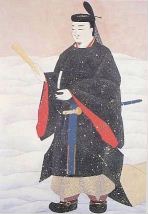|
Itإچ Suketaka
was a samurai, ''daimyإچ'' and twelfth family leader of the Itإچ clan, which was active from the Sengoku period to the Azuchi–Momoyama period. Today, Suketaka is regarded as the "ruler of virtue of the middle-Itإچ clan". Biography Suketaka was Itإچ Yoshisuke's third son. Early Conflicts In the year Eiroku 11 (1568), Suketaka entered Obi castle and conquered the Shimazu clan. In the year Tenshإچ (Momoyama period), Tenshإچ 5 (1577), Yoshisuke's vassals, in particular Fukunaga Suketomo and Mera Norishige, betrayed Suketaka. The Shimazu clan used this opportunity to invade the Itإچ clan. As a result, Suketaka and his father were forced to flee. They walked from Mera mountain to Takachiho, where they asked Otomo Sإچrin for protection. Sإچrin agreed to this request, as his ambition was to "[make] Hyuga province a Christian land." Sإچrin invaded Hyإ«ga Province and fought against the Shimazu clan, but his army was defeated in the Battle of Mimigawa at the Mimi river. Sإچrin lost mo ... [...More Info...] [...Related Items...] OR: [Wikipedia] [Google] [Baidu] |
Sengoku Period
The was the period in History of Japan, Japanese history in which civil wars and social upheavals took place almost continuously in the 15th and 16th centuries. The Kyإچtoku incident (1454), إŒnin War (1467), or (1493) are generally chosen as the period's start date, but there are many competing historiographies for its end date, ranging from 1568, the date of Oda Nobunaga#Ise campaign, Omi campaign, and march to Kyoto, Oda Nobunaga's march on Kyoto, to the suppression of the Shimabara Rebellion in 1638, deep into what was traditionally considered the Edo period. Regardless of the dates chosen, the Sengoku period overlaps substantially with the Muromachi period (1336–1573). This period was characterized by the overthrow of a superior power by a subordinate one. The Ashikaga shogunate, the ''de facto'' central government, declined and the , a local power, seized wider political influence. The people rebelled against the feudal lords in revolts known as . The period saw a break ... [...More Info...] [...Related Items...] OR: [Wikipedia] [Google] [Baidu] |
Fujiwara Clan
The was a powerful family of imperial regents in Japan, descending from the Nakatomi clan and, as legend held, through them their ancestral god Ame-no-Koyane. The Fujiwara prospered since ancient times and dominated the imperial court until the Meiji Restoration in 1868. They held the title of Ason. The abbreviated form is . The 8th century clan history states the following at the biography of the clan's patriarch, Fujiwara no Kamatari (614–669): "Kamatari, the Inner Palace Minister who was also called â€کChإ«rإچ'',''’ was a man of the Takechi district of Yamato Province. His forebears descended from Ame no Koyane no Mikoto; for generations they had administered the rites for Heaven and Earth, harmonizing the space between men and the gods. Therefore, it was ordered their clan was to be called إŒnakatomi" The clan originated when the founder, Nakatomi no Kamatari (614–669) of the Nakatomi clan, was rewarded by Emperor Tenji with the honorific "Fujiwara"after the w ... [...More Info...] [...Related Items...] OR: [Wikipedia] [Google] [Baidu] |
Shimazu Clan
The were the ''daimyإچ'' of the Satsuma han, which spread over Satsuma, إŒsumi and Hyإ«ga provinces in Japan. The Shimazu were identified as one of the '' tozama'' or outsider ''daimyإچ'' familiesAppert, Georges ''et al.'' (1888). in contrast with the '' fudai'' or insider clans which were hereditary vassals or allies of the Tokugawa clan. History The Shimazu were descendants of the Seiwa Genji branch of the Minamoto. The Shimazu would become one of the families of Edo period ''daimyإچ'' to have held their territory continuously since the Kamakura period, and would also become, at their peak, the wealthiest and most powerful Tozama daimyإچ family with an income in excess of 700,000 ''koku''. The founder, Shimazu Tadahisa (d. 1227), was a son of ''Shإچgun'' Minamoto no Yoritomo (1147–1199) with the sister of Hiki Yoshikazu. Tadahisa's wife was a daughter of Koremune Hironobu, a descendant of the Hata clan, whose name Tadahisa took at first. He received the domain ... [...More Info...] [...Related Items...] OR: [Wikipedia] [Google] [Baidu] |
é¹؟ه…گه³¶çœŒ
is a prefecture of Japan located on the island of Kyushu and the Ryukyu Islands. Kagoshima Prefecture has a population of 1,527,019 (1 February 2025) and has a geographic area of 9,187 km2 (3,547 sq mi). Kagoshima Prefecture borders Kumamoto Prefecture to the north and Miyazaki Prefecture to the northeast. Kagoshima is the capital and largest city of Kagoshima Prefecture, with other major cities including Kirishima, Kanoya, and Satsumasendai. Kagoshima Prefecture is located at the southernmost point of Kyإ«shإ« and includes the Satsunan Islands group of the Ryukyu Islands. Kagoshima Prefecture's mainland territory extends from the Ariake Sea to Shibushi Bay on the Pacific Ocean coast, and is characterized by two large peninsulas created by Kagoshima Bay. Kagoshima Prefecture formed the core of the Satsuma Domain, ruled from Kagoshima Castle, one of the most important Japanese domains of the Edo period and the Meiji Restoration. History Kagoshima Prefecture corresponds ... [...More Info...] [...Related Items...] OR: [Wikipedia] [Google] [Baidu] |

